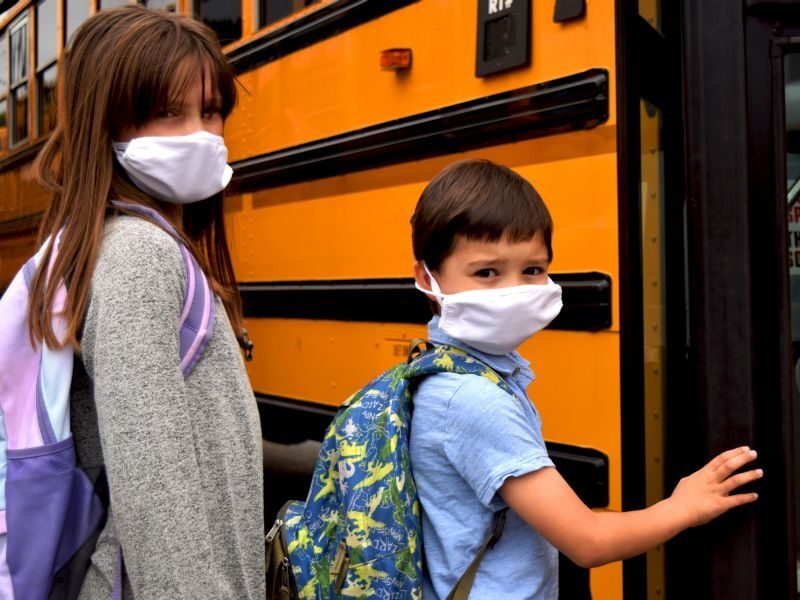FRIDAY, Feb. 12, 2021 (HealthDay News) — It may be safe for many of America’s kids to head back to classrooms, experts at the U.S. Centers for Disease Control and Prevention announced on Friday.
According to the agency’s new operational guidance, schools can safely reopen if they employ five key “layered mitigation” strategies based on the level of COVID-19 transmission in their communities. Those strategies include steps such as universal mask-wearing and physical distancing .
Each intervention will “provide some level of protection, but when implemented together, or layered, they provide the greatest level of protection,” CDC Director Dr. Rochelle Walensky said during an afternoon media briefing.
The CDC recommends that schools adopt universal and correct use of masks as the centerpiece of all reopening strategies, as well as enforcing physical distancing of at least 6 feet, Walensky said.
“These two strategies are incredibly important in areas that have high community spread of COVID-19, which right now is the vast majority of communities in the United States,” Walensky said. “We know that most clusters in the school setting have occurred when there are breaches in mask wearing.”
The CDC says schools should also promote three other steps to prevent COVID transmission: Frequent hand washing; thorough cleaning and disinfection practices; and rapid contact tracing by local health departments whenever new infections occur.
The new CDC documents provide a color-coded guide for reopening strategies schools should employ, depending on the level of COVID transmission in their community.
“At low levels of community transmission — levels that currently are only in less than 5% of our nation’s counties — CDC recommends that schools can provide full in-person instruction with universal use of masks and other mitigation strategies,” Walensky said. “However, as levels of community transmission rise into high levels, as is currently the case in over 90% of our counties, schools should require physical distancing of at least six feet and reduce sports and other extracurricular activities.”
Road map to re-opening
Schools in communities with substantial transmission rates likely will have to operate in a hybrid mode with reduced attendance, while middle and high schools in high transmission areas will need to continue virtual instruction unless they can strictly enforce mitigation strategies and prevent outbreaks, the documents say. Those tougher steps might include weekly coronavirus testing of students and staff to help spot asymptomatic infections.
Walensky stressed that the CDC is not ordering that schools reopen or close based on local conditions.
“These recommendations simply provide schools a long-needed road map for how to do so safely under different levels of disease in the community,” Walensky said.
President Joe Biden has set a goal of reopening most K-12 schools during his first 100 days in office, but has stressed that medical science will dictate the means by which schools safely reopen.
School closures prompted by the pandemic have caused students to go hungry, falter in their education and endure social isolation, Donna Harris-Aikens, a senior advisor for policy and planning at the U.S. Department of Education, said during Friday’s briefing.
“For these reasons and more, we need to get kids back in the classroom,” Harris-Aikens said.
Vaccination, ventilation
Annette Anderson, deputy director of the Johns Hopkins Center for Safe and Healthy Schools, said she is “excited by what I heard today.”
“We have felt like schools and districts have been on their own for most of this pandemic,” Anderson said. “It has just felt like 14,000 districts coming up with 14,000 different plans.”
“Now we are receiving clear signals from the Biden administration that there is a shift, that there is someone who is going to take this on at the federal level,” Anderson continued.
The CDC guidance also address staff vaccinations and improved ventilation as two other strategies that can help prevent COVID transmission in schools. Improved ventilation might mean opening school windows and doors when safe and appropriate.
As to the rollout of COVID-19 vaccines, “our operational strategy specifically has vaccination as an additional layer of protection that can be added to the recommended five key mitigation strategies,” Walensky said.
But evidence has led the CDC to conclude that vaccination is not essential to school reopening, if the other strategies are pursued. That assertion has met with considerable pushback from teacher’s unions across the country, however.
“It’s one of those layers of mitigation we believe will help, but we believe and the science has demonstrated that schools can be reopened safely prior to all teachers being vaccinated,” Walensky said.
The science has shown that most transmission at school occurs from staff-to-staff, she said.
More information
The U.S. Centers for Disease Control and Prevention have more about school reopening strategy.
SOURCES: Feb. 12, 2021, media briefing with: Rochelle Walensky, MD, MPH, director, U.S. Centers for Disease Control and Prevention; Annette Anderson, PhD, deputy director, Johns Hopkins Center for Safe and Healthy Schools; Donna Harris-Aikens, JD, senior advisor, policy and planning, U.S. Department of Education
Copyright © 2025 HealthDay. All rights reserved.

